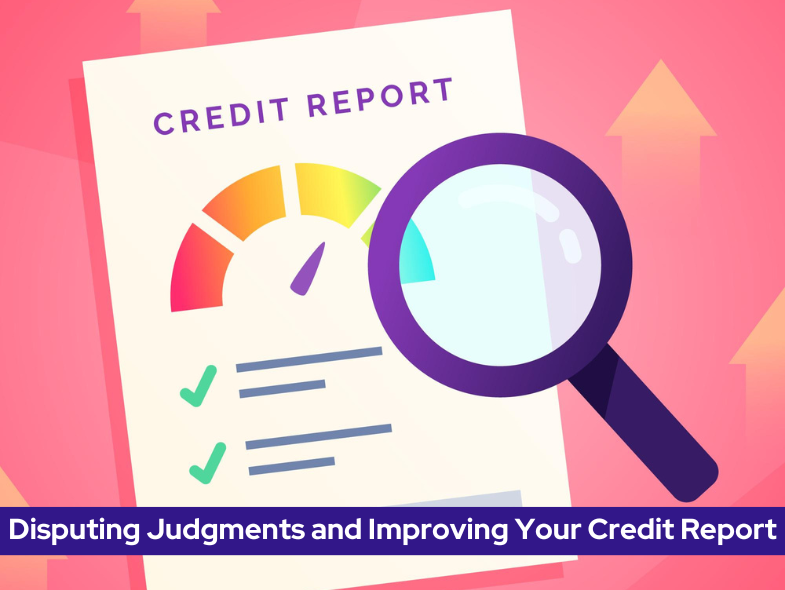Lenders use your credit report, which is similar to a financial report card, to assess your creditworthiness. A summary of your credit history is given, along with any judgments rendered against you. Your credit score and your ability to obtain loans or credit cards might both suffer significantly from judgments. It’s not a life sentence, though. You can challenge judgments and attempt to have them removed from your credit record using the correct tactics.
Understanding Judgments
Understanding the nature and significance of judgments is crucial before analyzing conflict resolution tactics. A judgment is a statement of debt made by a court, typically as a result of legal action taken by a creditor due to unpaid bills. If the judge finds in the creditor’s favor, a judgment is rendered against you. The results are severe, lowering your credit score and staying on your credit report for as long as seven years. When creditors resort to legal action to compel payment after trying alternative means of debt collection to no avail, judgments frequently result. Once a judgment shows up on your credit record, it could make it harder for you to get new credit, get lower loan interest rates, or find housing or work.
Reviewing Your Credit Report
Obtaining copies of your credit report from the three main credit agencies, Equifax, Experian, and TransUnion, is the first step in the process of contesting judgments. You are entitled to one free credit report from each bureau per year under the Fair Credit Reporting Act (FCRA), and you can view them at AnnualCreditReport.com, the only website the Federal Trade Commission has approved for this use. To find any judgments listed, each report must be carefully examined. Judgments that were previously unknown may now be found, as creditors or collection agencies occasionally fail to notify debtors of imminent legal actions. By routinely checking your credit report, you can quickly address these problems and take appropriate action.
Validating the Judgment
It’s imperative to confirm the accuracy of a ruling before filing a challenge to it. It’s crucial to verify that the judgment information is genuinely factually accurate because mistakes can happen. Common errors include disparities in the sums owed, dates that are off, or judgements that were incorrectly ascribed. A judgment is said to be validated when you determine that it was accurately conveyed. When spotting discrepancies, make a point of gathering proof, such as receipts, payment records, court records, or any relevant data that substantiates the judgment’s veracity.
Disputing Inaccuracies
If you suspect an inaccurately reported judgment on your credit, you have the legal right to dispute it. The dispute process involves informing the credit bureau responsible for the information and presenting evidence to support your claim. Here’s how to proceed:
Craft a Well-Structured Dispute Letter:
It’s crucial to draft a well-written dispute letter for a successful dispute. In the letter, ensure you include the following details:
Your Personal Information:
Provide your name, current address, Social Security number, and, if available, the credit report reference number.
Judgment Details:
Clearly specify the judgment you’re disputing, including relevant information such as the owed amount, the creditor’s name, and the judgment’s date.
Explain the Discrepancy:
Clearly and concisely articulate why you believe the judgment is inaccurate. Mention any supporting evidence you possess and clearly state your request for the judgment’s removal from your credit report.
Request an Investigation:
Politely ask the credit bureau to investigate the disputed information. Maintain professionalism and avoid emotional language.
Include Supporting Documents:
Attach copies of any documents that back your dispute, like payment receipts, court records, or communications with the creditor.
Dispatch the Dispute Letter:
Send your dispute letter through certified mail, requesting a return receipt. This step provides evidence that the credit bureau received your dispute, which can be vital in demonstrating your action.
Keep Records:
Ensure you maintain a copy of your dispute letter, any enclosed documents, and the return receipt. Record the date of sending the letter and the date of receipt.
Exercise Patience:
Once the credit bureau receives your dispute, they have a 30-day window to conduct an investigation. They will reach out to the creditor to validate the information. If the creditor cannot provide sufficient evidence, the judgment must be removed from your credit report. Nevertheless, patience is essential to allow the process to proceed.
Seeking Legal Advice
While the above-mentioned steps are often sufficient to dispute judgments, there may be circumstances where seeking legal advice is necessary. Complex legal issues or persistent disputes may warrant the expertise of an attorney who specializes in credit and debt matters. An attorney can guide you through the legal process, help negotiate settlements, and advise you on the best course of action to improve your credit report.
Conclusion
One of the most important steps you can do to better your financial situation and secure your future is to dispute judgements on your credit report. You may take charge of your creditworthiness and open the door to a better financial future by understanding the process and putting the tips from this article into practice. Keep in mind that throughout this process, persistence and attention to detail are essential. Be patient if results don’t appear right away; every action you take moves you one step closer to a better credit score and more favorable financial prospects. You may start fresh and achieve the financial freedom you deserve with the correct strategy.
FAQs
1. How does a credit judgment impact my credit report and what is it?
A credit judgment is a legal ruling that declares you are indebted, and it has adverse effects on your credit report, potentially causing difficulties in obtaining loans, housing, or employment.
2. Will disputing a judgment guarantee its removal from my credit report?
Disputing a judgment does not guarantee its removal, but it initiates a process where the credit bureau investigates the accuracy of the information. If the creditor cannot substantiate the judgment, it will likely be removed.
3. What details should I include in a disagreement letter to contest a decision?
Your dispute letter needs to include information about you personally, the specifics of the ruling you’re contesting, an explanation of the disagreement, a demand for an investigation, and copies of any supporting documentation.




